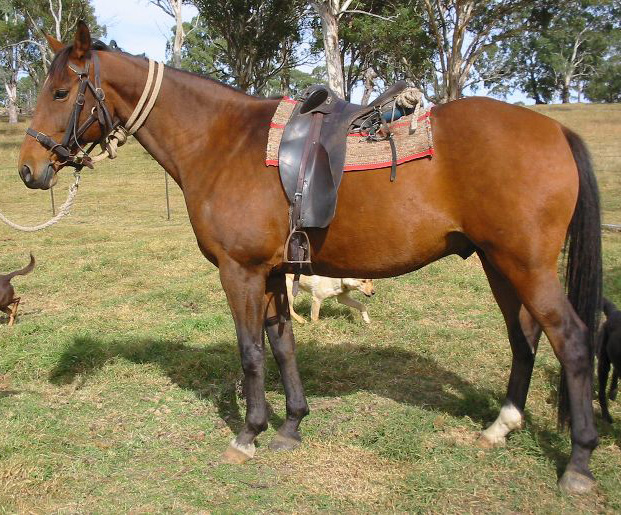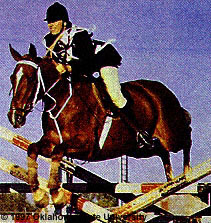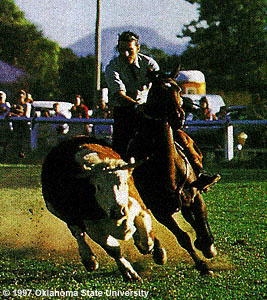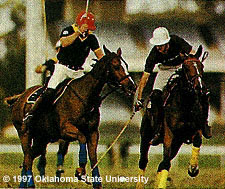Australian Stock Horses
The Australian Stock Horse evolved through selective  breeding in response to the demands of the environment. The history of the breed began
in 1788 with the arrival of the First Fleet which brought the first horses to the
colony of N.S.W., as the whole of eastern Australia was then known. These horses were
of English Thoroughbred and Spanish stock; later importations included more Thoroughbreds, Arabs and Timor and Welsh Mountain ponies.
breeding in response to the demands of the environment. The history of the breed began
in 1788 with the arrival of the First Fleet which brought the first horses to the
colony of N.S.W., as the whole of eastern Australia was then known. These horses were
of English Thoroughbred and Spanish stock; later importations included more Thoroughbreds, Arabs and Timor and Welsh Mountain ponies.
Horses arriving in the colony needed strength and stamina - not only to survive the long sea voyage (which took between nine and twelve months) - but also to work in foreign, untamed environment which had become their home. After the crossing of the Blue Mountains as settlers ventured inland, strong and reliable horses became a necessity. Explorers, stockmen, settlers, bushrangers and troopers all relied on horses which could travel long distances day after day. Weak horses were culled, and only the stronger types were used to breed the sturdy saddle horses essential for the colony's development.
 Despite the mixed origins of these horses, they developed into a strong and handsome
type which was eventually called the Waler after the colony of N.S.W. J.C. Byrne in
his "Twelve Years Wandering the British Colonies" (1848) wrote "...the race of horse
at present in use in Australia is not to be surpassed in the world for symmetry and
endurance. It is hard to say exactly how they are bred for there have been large importations
of mares from Chile and Peru, stallions of the pure Arab breed from India, and also
from England and the Cape of Good Hope. Much pains have been bestowed on the breeding
of these animals and the results have rightly rewarded the exertion." Exploits of
the explorers and stockmen and their reliable horses in the Australian bush became
folklore, and stories such as "The Man from Snowy River" and "Clancy of the Overflow"
depict the character of these pioneers and their horses.
Despite the mixed origins of these horses, they developed into a strong and handsome
type which was eventually called the Waler after the colony of N.S.W. J.C. Byrne in
his "Twelve Years Wandering the British Colonies" (1848) wrote "...the race of horse
at present in use in Australia is not to be surpassed in the world for symmetry and
endurance. It is hard to say exactly how they are bred for there have been large importations
of mares from Chile and Peru, stallions of the pure Arab breed from India, and also
from England and the Cape of Good Hope. Much pains have been bestowed on the breeding
of these animals and the results have rightly rewarded the exertion." Exploits of
the explorers and stockmen and their reliable horses in the Australian bush became
folklore, and stories such as "The Man from Snowy River" and "Clancy of the Overflow"
depict the character of these pioneers and their horses.
The hardiness of the Waler made him a natural mount for the cavalry and when the British found themselves undermounted at the time of the Indian Mutiny, the Waler came to the rescue. The earliest shipment to India was in 1857 when 29 horses were sent from Sydney to Calcutta. They proved superior to the local breeds and the remount officers were quickly commissioned to buy more. They initially chose 250 - a small number compared with later purchases - during 1858, 2500 were sent to India. In the Boer War, the Waler was exported in even greater numbers and from 1899 to 1902 about 16,000 horses served in such regiments as the Lancers, Commonwealth Horse, Mounted Rifles and Bushman's Troop.
 Later, in the Middle East during the First World War, the British generals called
again for Australian Light Horse regiments and their Light Horse regiments and their
stock horse remounts. About 160,000 Australian horses served in World War I with generals
and cavalrymen from 20 nations, from both sides, accepting that these horses were
more reliable and had greater endurance than other breeds. The English cavalryman,
Lt. Col. R.M.P. Preston, D.S.O., in his book "The Desert Mounted Corps" described
the stamina and spirit of the Australian Light Horse"... Calvary Division had covered
nearly 170 miles... and their horses had been watered on an average of once in every
36 hours... The heat, too, had been intense and the short rations, 9 1/2 lbs. of grain
per day without bulk food, had weakened them considerably. Indeed, the hardship endured
by some horses was almost incredible. One of the batteries of the Australian Mounted
Division had only been able to water its horses three times in the last nine days
- the actual intervals being 68, 72 and 76 hours respectively, yet this battery on
its arrival had lost only eight horses from exhaustion... the majority of the horses
in the Corps were Walers, and there is no doubt that these hardy Australian horses
make the finest cavalry mount in the world...." Sadly, only one Waler returned after
the war; the remainder were either killed in action or shot to ensure that they would
not fall into the hands of the Arabs or Egyptians. This was indeed a great tragedy
for the Australian Lighthorsemen who were so proud of their horses. Although many
good breeding stock left Australia never to return, the huge shipments did not seem
to affect the horses population at home. In 1906, Australia has 1,765,186 horses and
in 1918 when the human census was 5,030,479 there were 2,527,149 horses.
Later, in the Middle East during the First World War, the British generals called
again for Australian Light Horse regiments and their Light Horse regiments and their
stock horse remounts. About 160,000 Australian horses served in World War I with generals
and cavalrymen from 20 nations, from both sides, accepting that these horses were
more reliable and had greater endurance than other breeds. The English cavalryman,
Lt. Col. R.M.P. Preston, D.S.O., in his book "The Desert Mounted Corps" described
the stamina and spirit of the Australian Light Horse"... Calvary Division had covered
nearly 170 miles... and their horses had been watered on an average of once in every
36 hours... The heat, too, had been intense and the short rations, 9 1/2 lbs. of grain
per day without bulk food, had weakened them considerably. Indeed, the hardship endured
by some horses was almost incredible. One of the batteries of the Australian Mounted
Division had only been able to water its horses three times in the last nine days
- the actual intervals being 68, 72 and 76 hours respectively, yet this battery on
its arrival had lost only eight horses from exhaustion... the majority of the horses
in the Corps were Walers, and there is no doubt that these hardy Australian horses
make the finest cavalry mount in the world...." Sadly, only one Waler returned after
the war; the remainder were either killed in action or shot to ensure that they would
not fall into the hands of the Arabs or Egyptians. This was indeed a great tragedy
for the Australian Lighthorsemen who were so proud of their horses. Although many
good breeding stock left Australia never to return, the huge shipments did not seem
to affect the horses population at home. In 1906, Australia has 1,765,186 horses and
in 1918 when the human census was 5,030,479 there were 2,527,149 horses.
Forming the Breed
 After the First World War, despite the recognition Australian horses had won and although
the Waler was known as a distinctive type, there was not stud book or registry. Mechanization
of primary industries reduced the need for working horses and it was not until the
1960s that an interest in horses was revived. This revival sprang from the increasing
leisure time available to society. At the 1971 Sydney Royal Show, Mr. Alex Braid of
Wellington, N.S.W., and Mr. Bert Griffith of Scone gathered a group of enthusiasts
together to discuss the formation of a society. In June, 1971, about 100 people met
at Tamworth to launch the Australian Stock Horse Society, which at last gave our home-bred
horses the recognition and formal organization they deserved. The first step was to
appoint classifiers who could asses horses offered for inspection. To qualify for
inclusion in the Australian Stock Horse Stud Book a horse had to score at least 50
points out of a possible 100; stallions and mares scoring slightly less than 50, and
all acceptable geldings went into an appendix. The maximum score is broken down into
60 points for conformation, 20 points for breeding and 20 points for ability. The
Society quickly spread and branches were soon formed in Queensland, South Australia
and the Northern Territory. The movement reached Victoria in 1973 and later Western
Australia and Tasmania. By 1979 membership had increased from the initial hundred
to 12000 and the society's classifiers had accepted more than 40000 horses for registration.
After the First World War, despite the recognition Australian horses had won and although
the Waler was known as a distinctive type, there was not stud book or registry. Mechanization
of primary industries reduced the need for working horses and it was not until the
1960s that an interest in horses was revived. This revival sprang from the increasing
leisure time available to society. At the 1971 Sydney Royal Show, Mr. Alex Braid of
Wellington, N.S.W., and Mr. Bert Griffith of Scone gathered a group of enthusiasts
together to discuss the formation of a society. In June, 1971, about 100 people met
at Tamworth to launch the Australian Stock Horse Society, which at last gave our home-bred
horses the recognition and formal organization they deserved. The first step was to
appoint classifiers who could asses horses offered for inspection. To qualify for
inclusion in the Australian Stock Horse Stud Book a horse had to score at least 50
points out of a possible 100; stallions and mares scoring slightly less than 50, and
all acceptable geldings went into an appendix. The maximum score is broken down into
60 points for conformation, 20 points for breeding and 20 points for ability. The
Society quickly spread and branches were soon formed in Queensland, South Australia
and the Northern Territory. The movement reached Victoria in 1973 and later Western
Australia and Tasmania. By 1979 membership had increased from the initial hundred
to 12000 and the society's classifiers had accepted more than 40000 horses for registration.
References
The Australian Stock Horse Society Limited, SCONE NSW, Australia
